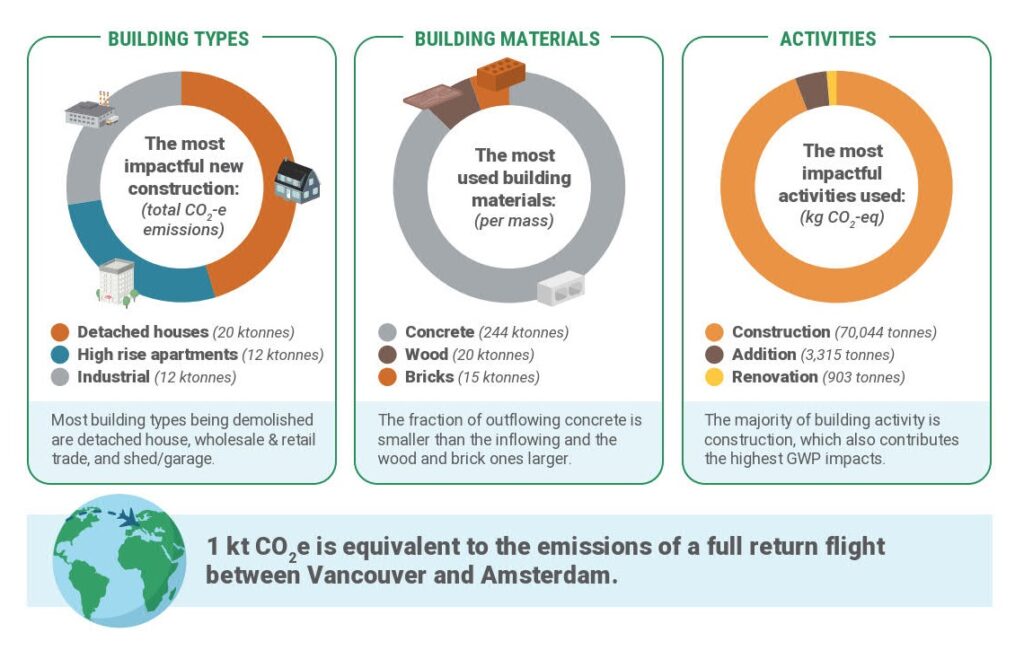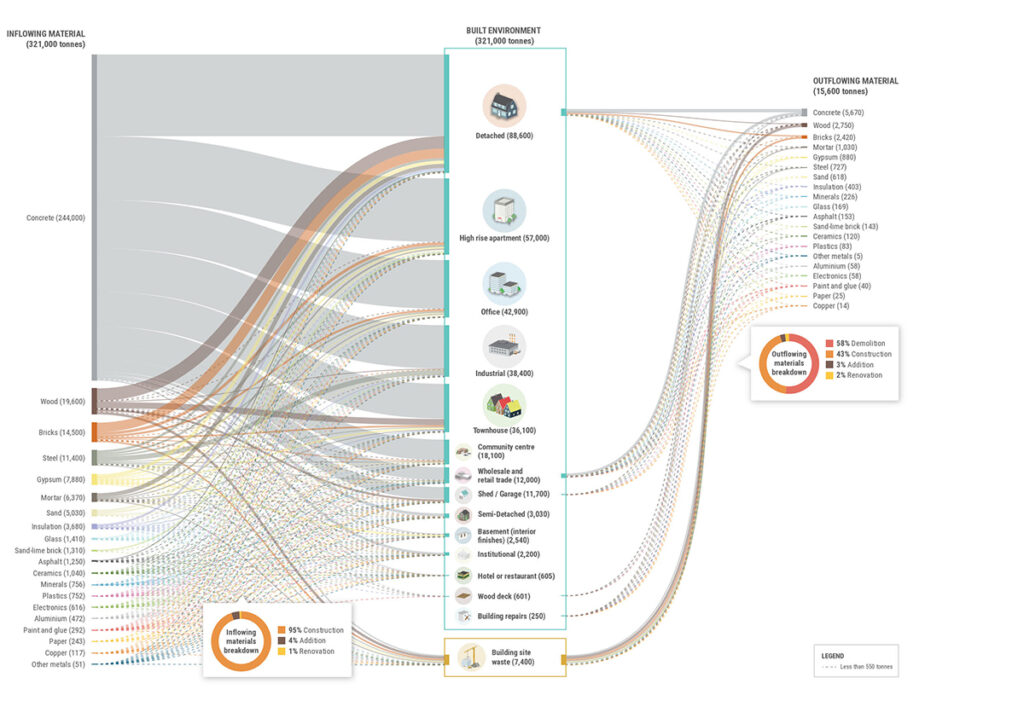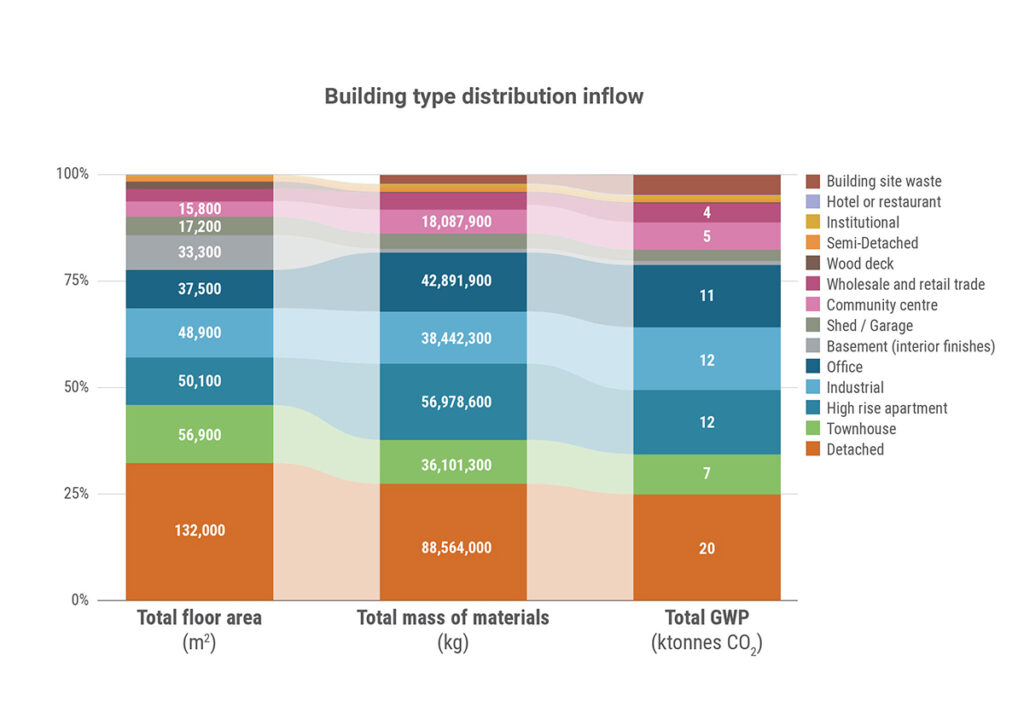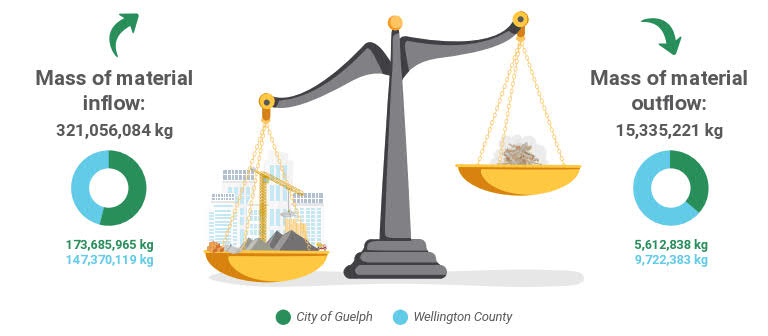Projects
Material Flow Analysis – Guelph, ON
Through the City of Guelph’s Circular Opportunities Innovation Lab (COIL) and Zero Waste Economic Transformation Lab (ZWETL), Dillon Consulting, Metabolic and Summit72 have researched circular economy opportunities for the construction, renovation and demolition (CRD) sectors.
The research included a material flow analysis (MFA) of CRD materials consumed and/or generated within the City of Guelph and the County of Wellington in 2021. Multiple data sources were collected and Metabolic’s Urban Mining Model (UMM) was used to provide insights into the quantity and types of building materials used and the current disposal methods for materials arising from CRD activities.

This baseline assessment of CRD material flows provides a foundation for key stakeholders in the Guelph-Wellington study area to identify high-impact opportunities that can help transition the built environment to a more circular state. The UMM was selected as a methodological tool for the project following a preliminary analysis of the availability of data that could inform the MFA. The UMM was adapted to the Ontario context, verified by a Dillon architect, and populated with data that included local building permits from the City of Guelph and County of Wellington. The Co-operators Insurance also provided data to the analysis, which offered insight into types and quantities of waste that arises from damage repairs. Also, based on insights provided by a local expert working on building sites, we incorporated a waste fraction to new building materials (estimated at 10-15% by mass).

As a result, the team was able to estimate the CRD material flows in the Guelph-Wellington area and associated environmental impacts of materials used for new construction, as well as waste types and quantities generated by renovation and demolition activities. Although attempts were made to gather data through local stakeholders in the CRD waste management sector, no data was made available. As waste management companies are not required to publicly report the quantities of CRD waste they handle, reliable data is a limiting factor in the results of this study. Further data would have allowed for a more detailed analysis that identified specific opportunities to intervene in the CRD sector including pinpointing areas where material reuse efforts could be concentrated.

The study’s findings showed that new construction contributed most to material consumption (86%) as compared to renovations or additions on existing buildings. The current housing crisis explains the large number of residential building activities in the region, accounting for 72% of all building activities based on floor area of permits in 2021. When looking at the impact per square meter of building activities, we can see that construction, due to its higher material density, has a much higher impact than renovation and additions.

As well as being more sustainable, renovations and additions to existing buildings would cost about 1.5 times less per square meter built than new construction. The value spent on new construction in Guelph-Wellington accounts for 10 times as much as what is spent on renovations and additions, while about seven times the renovation and addition area represents the new construction area.
The Guelph-Wellington study area can be considered to have relatively standard CRD practices in the North American context. With approximately 20 times more material entering the built environment than exiting, the region meets its housing and industrial space needs through urban expansion rather than reuse of what is already present in the local building stock. In addition, as is the case in many U.S. cities, tracking procurement and end-of-life processes has not yet become a common practice, making it difficult to adequately discover the potential of currently wasted materials and to identify more thorough pathways for the built environment to adopt circular economy practices.
The project was successful in illustrating the magnitude of materials consumed and waste generated and the associated environmental impacts as a result of CRD activities. The findings will feed into initiatives, led by COIL, to increase awareness and to increase reduction, reuse and recycling opportunities for the CRD sector.
Project Details
Project Partner: City of Guelph’s Circular Opportunities Innovation Lab
Business Unit: Waste Management
Service Offering: Advisory Services

